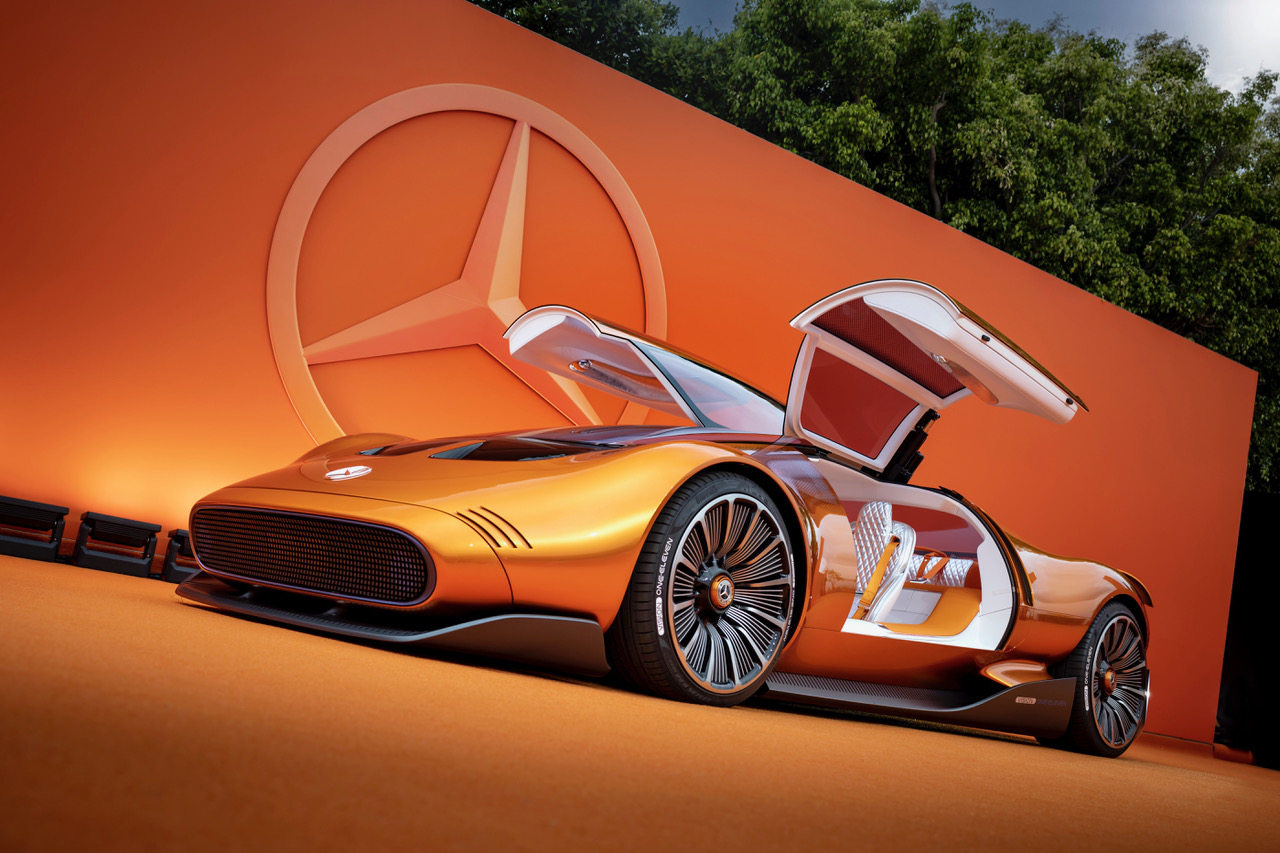
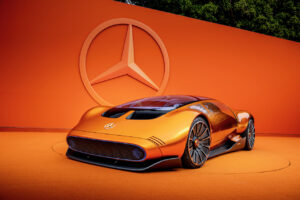
Mercedes-Benz presents a new sports car study. The Vision One-Eleven combines a highly dynamic design language with innovative all-electric powertrain technology. The supercar silhouette is characterised by skilful execution of the signature Mercedes-Benz One-Bow design that is a marker of its 21st‑century style. The development of this design underscores the positioning of the Mercedes-Benz brand, which stands for ICONIC LUXURY. Its technical highlights include the extremely powerful and highly efficient axial-flux motor developed by electric motor specialist YASA. The British company has been a 100-percent subsidiary of Mercedes-Benz AG since July 2021.
The Mercedes-Benz Vision One-Eleven is inspired by the tradition of the legendary C 111 experimental vehicles from the 1960s and 70s, which were used to test revolutionary Wankel and turbodiesel engines. They were also prototypes for testing polymer-based bodyshells. The extremely (aero)dynamic mid-engine sports cars are considered design icons of their era, not least due to their distinctive gullwing doors and eye-catching orange-and-black paintwork.
The exterior – One-Bow design in its most athletic form
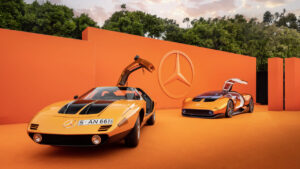
The body of the Mercedes-Benz Vision One-Eleven centres on skilful execution of the One-Bow design. From the low-slung front end to the muscular hind quarters, it runs in a smooth bow that endows the just 1,170 mm-high vehicle silhouette with an extremely sculptural feel. This harmonises perfectly with the copper-orange alubeam paintwork. It provides an unmistakeable reference to the distinctive colour of the C 111 without adopting it one-to-one. The colour of the Mercedes-Benz Vision One-Eleven is considerably more powerful than that of the C 111 and also changes with the light. It conveys not only a sense of quality but also a certain extravagance.
The front-end design – iconic high-tech look with historical reference

From the frontal aspect, too, the Mercedes-Benz Vision One-Eleven is powerfully evocative of the C 111. In detail, however, there are striking differences: One stand-out example is the distinctive front end, which on both vehicles consists of a low-lying rectangular element with rounded ends left and right. On the C 111, this is a closed plastic element with a honeycomb structure, fitted with round foglamps. The corresponding part on the Vision One-Eleven appears very similar at first glance. However, upon closer inspection, it reveals itself as a high-tech feature. The panel is a flexible external display with a 3D pixelated look. It interprets the C 111’s characteristic round lights in digitised form and can also convey messages to other road users.
The rear-end design – aerodynamic features and digital elements
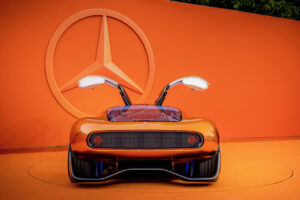
The rear-end of the Mercedes-Benz Vision One-Eleven is likewise dominated by a powerfully profiled diffuser. Spanning the breadth above it is a display that echoes the shape of its counterpart at the front end and features the same pixelated structure in the red taillights. Similar to the blade profiles along the sides, blue lighting effects are also visible at the rear. The inner face of the wheels is fitted with circular lighting elements.
Futuristic and luxurious ambience with contrasting colours
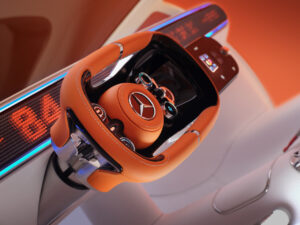
The interior design of the Vision One-Eleven reflects future luxury based on a progressive colour concept and extraordinary material combinations. The richly contrasting colours and materials attract attention at first glance: Large surfaces such as the dashboard are upholstered in white fabric displaying a tech-look honeycomb structure. The material is made from 100-percent recycled polyester.
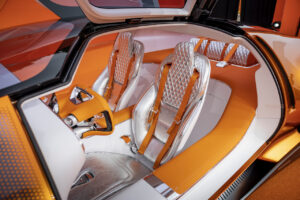 Other elements such as the armrests on the sills and centre console, as well as the rear parcel shelf beneath the expansive rear windscreen, are clad in bright orange leather. This creates a smooth transition from interior to luggage compartment. The sustainably processed leather was tanned using coffee bean husks. Polished aluminium in the steering-wheel spokes and inlaid as straps across the armrests underscore the tech look and feel. The same applies to the brake and accelerator pedals, both of which are made from polished aluminium and floor mounted.
Other elements such as the armrests on the sills and centre console, as well as the rear parcel shelf beneath the expansive rear windscreen, are clad in bright orange leather. This creates a smooth transition from interior to luggage compartment. The sustainably processed leather was tanned using coffee bean husks. Polished aluminium in the steering-wheel spokes and inlaid as straps across the armrests underscore the tech look and feel. The same applies to the brake and accelerator pedals, both of which are made from polished aluminium and floor mounted.
Innovative electric powertrain – high-performance axial-flux motor and all-new battery technology
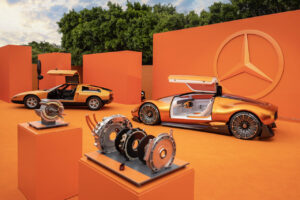
Technology highlights include a new battery concept featuring high-performance liquid-cooled cylindrical cells with a novel cell chemistry. Once more, the extensive knowledge of the motorsport experts from Mercedes-AMG High Performance Powertrain in Brixworth found its way into this promising concept for future performance-oriented batteries. Aside from that, the Vision One-Eleven features two exceptionally powerful and advanced axial-flux motors from YASA. Mercedes-Benz is developing this technology together with YASA to large scale production maturity for its next-generation electric drives. YASA is a British electric-motor specialist based in Oxford and has been a 100-percent subsidiary of Mercedes-Benz AG since July 2021. The company has thus secured access to a unique future technology that has the potential to take electric mobility to a new level of performance.